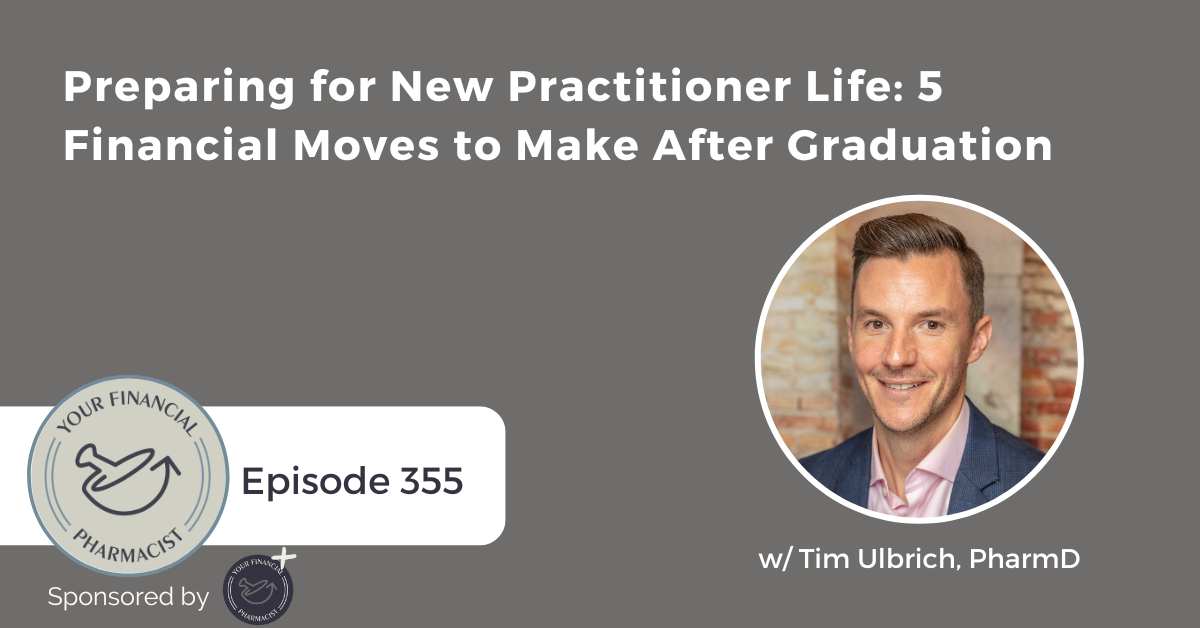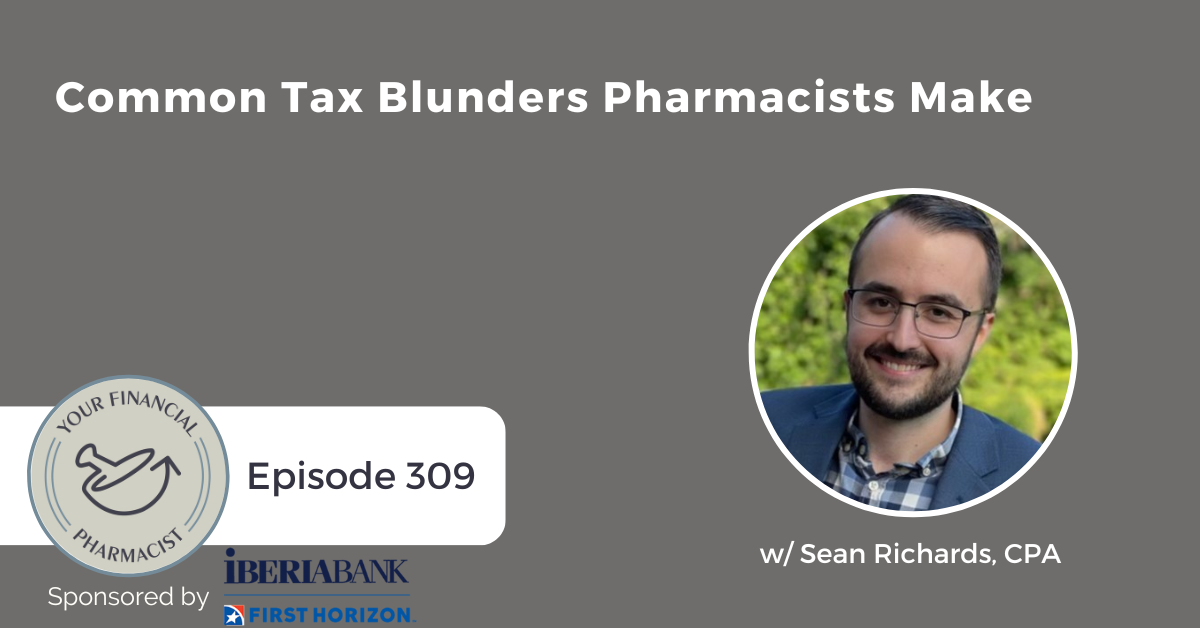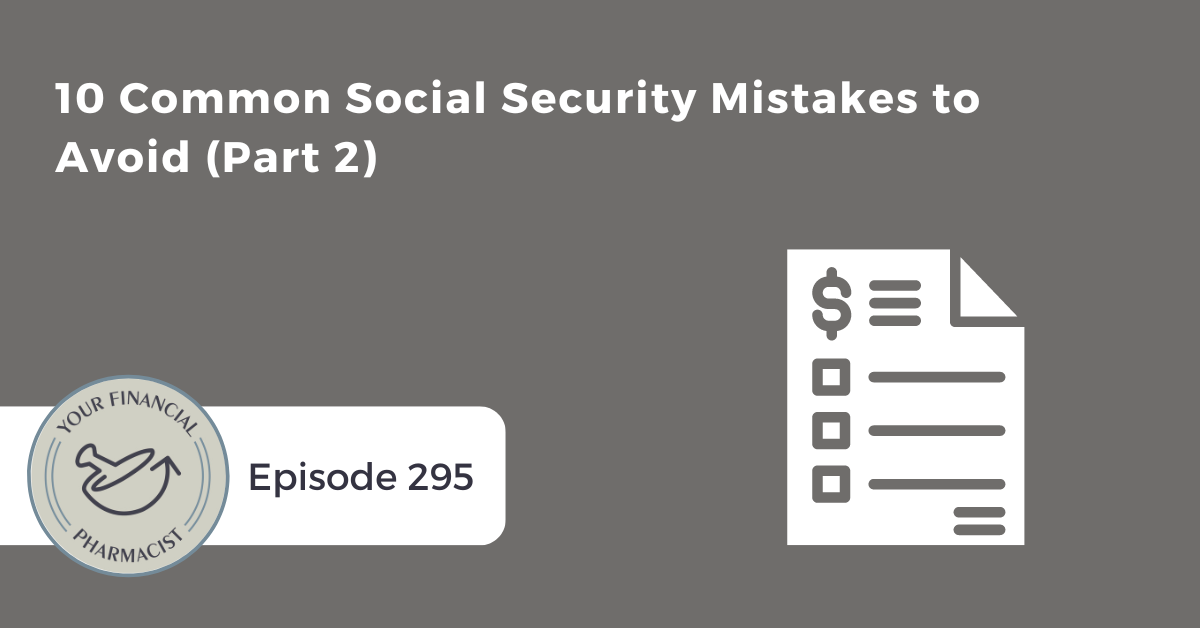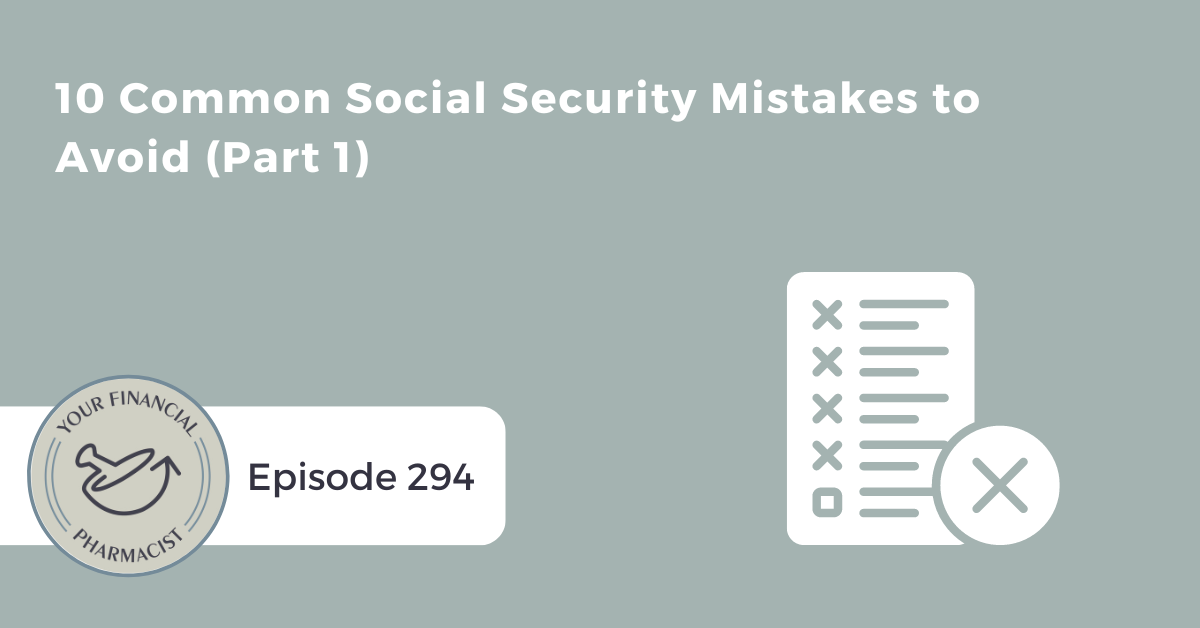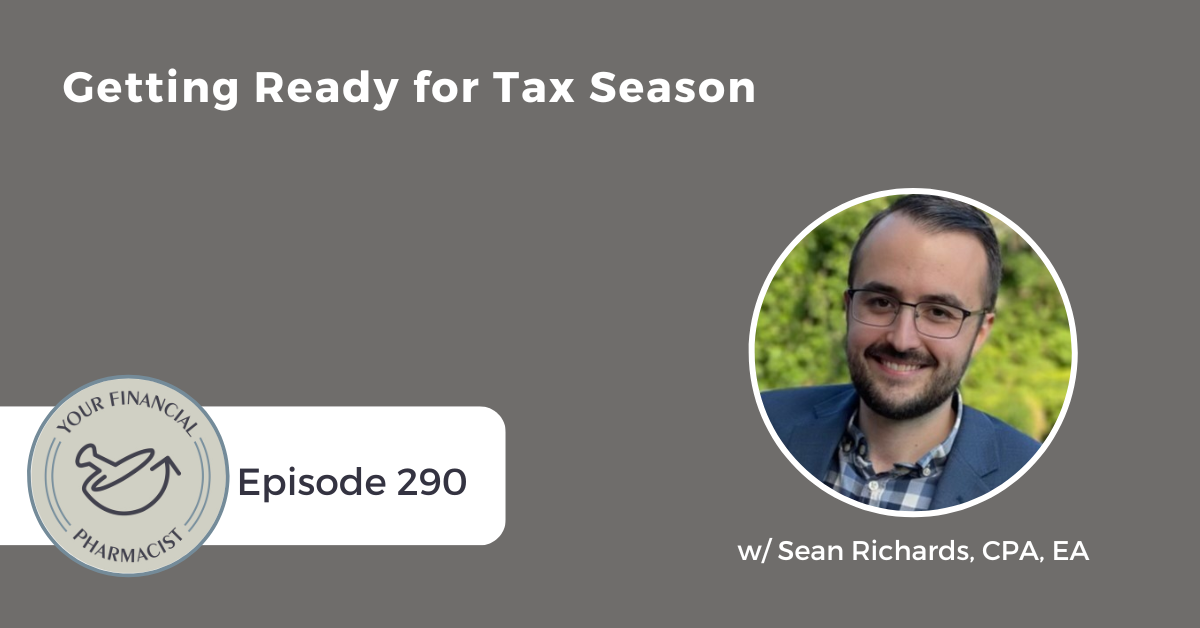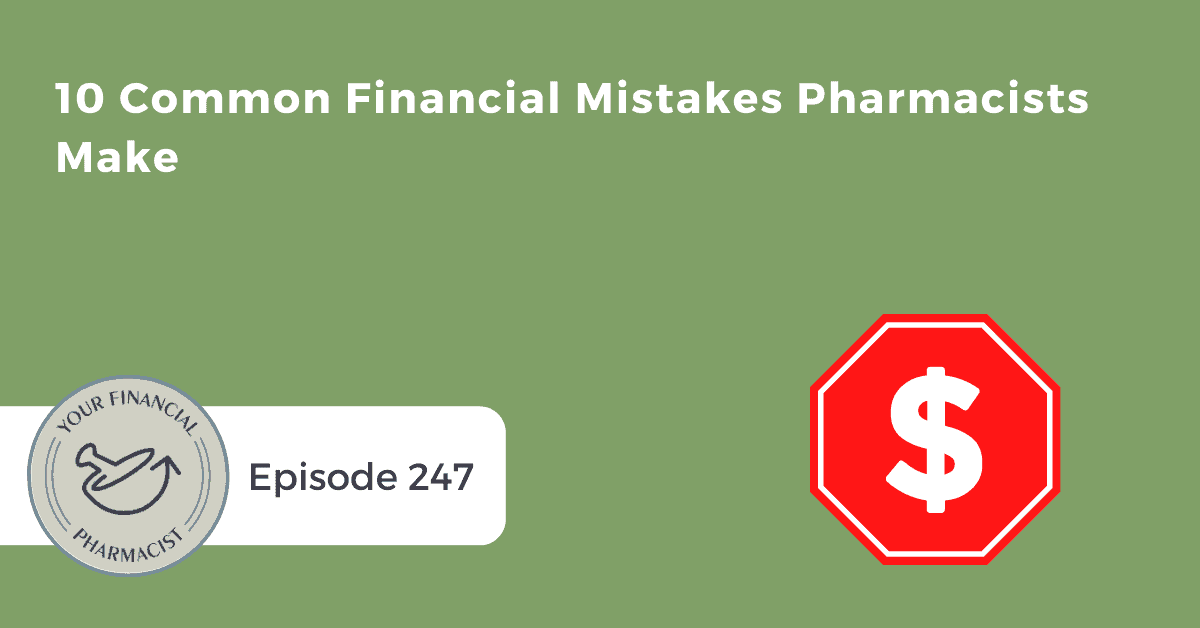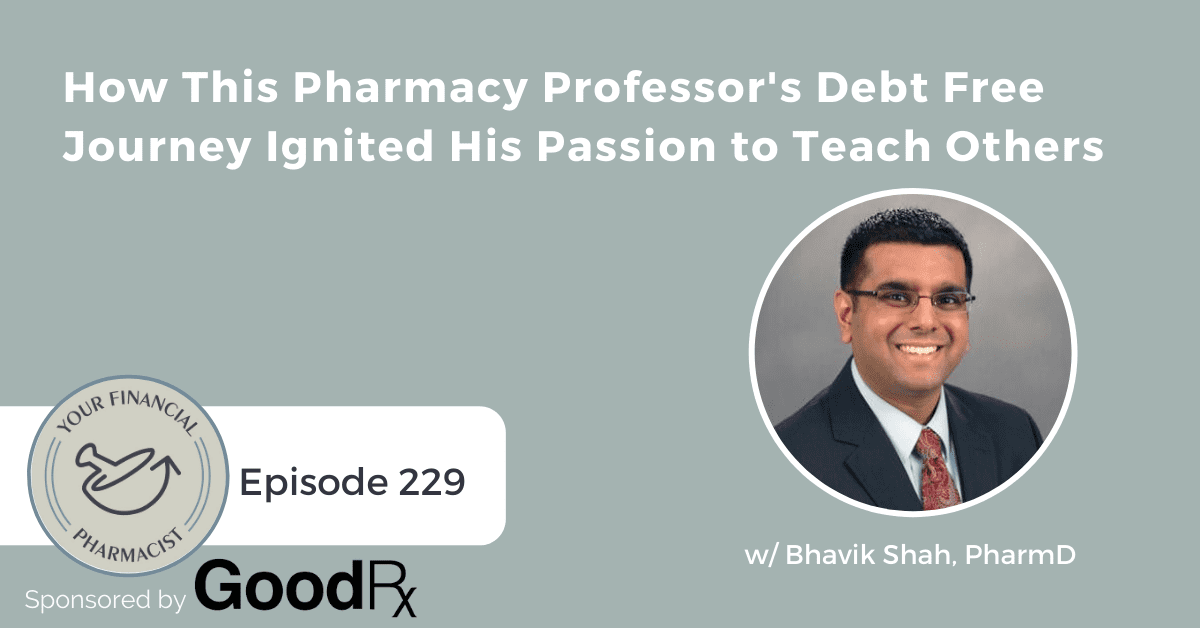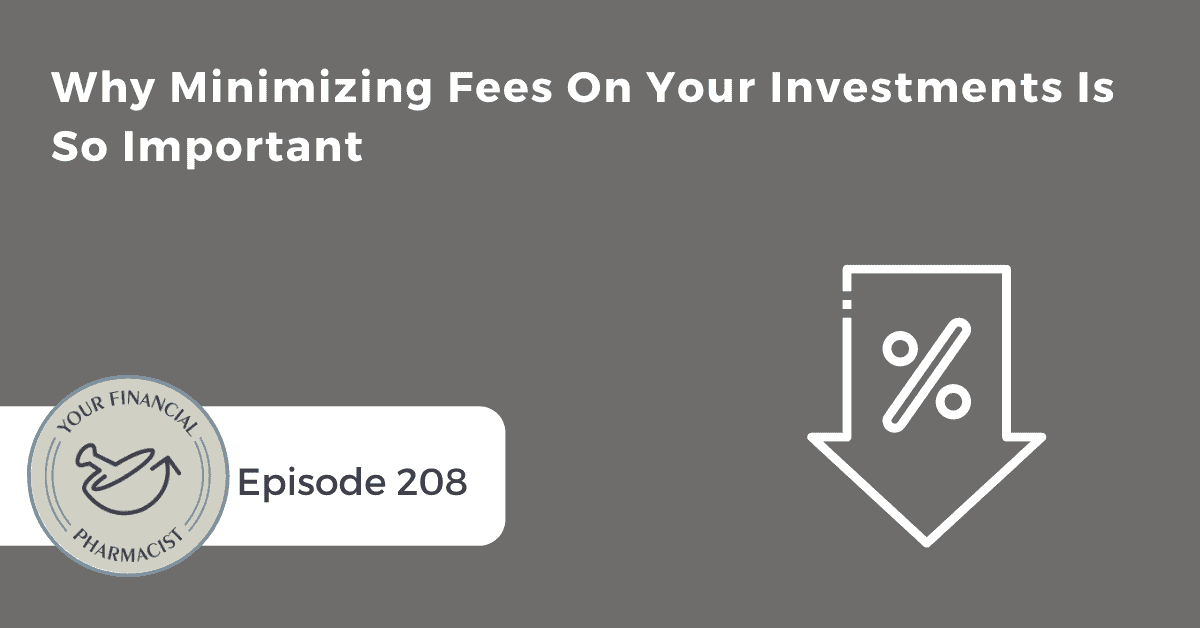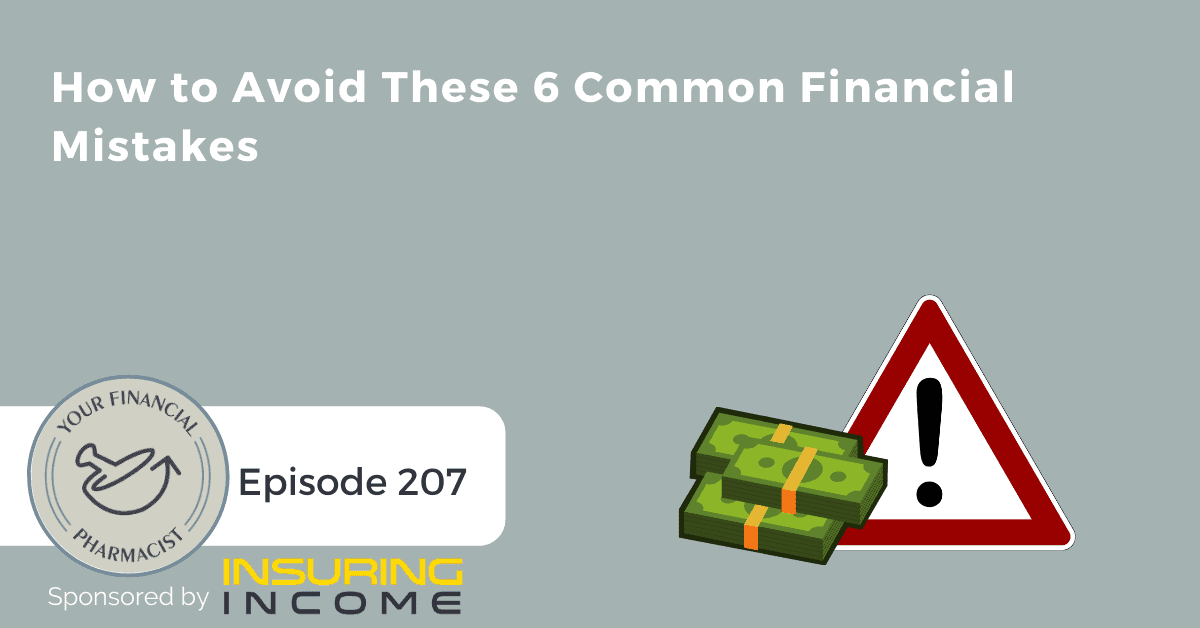Sponsored by YFP+, YFP Co-Founder Tim Ulbrich shares five key elements for building a strong financial foundation after graduation.
Episode Summary
On this episode sponsored by YFP+, host Tim Ulbrich outlines five key elements for building a strong financial foundation. Whether you are a pharmacy student looking ahead, a soon to be 2024 graduate, or a resident, fellow, or new practitioner trying to find solid financial footing, Tim shares what it means to build a strong financial foundation, no matter where you are in your career.
With the average pharmacist facing staggering student loan debt and often lacking financial knowledge, Tim shares practical strategies to help pharmacists to begin to navigate debt management, investing, insurance coverage and retirement planning.
About Today’s Guest
Tim Ulbrich is the Co-Founder and CEO of Your Financial Pharmacist. Founded in 2015, YFP is a fee-only financial planning firm and connects with the YFP community of 15,000+ pharmacy professionals via the Your Financial Pharmacist Podcast podcast, blog, website resources and speaking engagements. To date, YFP has partnered with 75+ organizations to provide personal finance education.
Tim received his Doctor of Pharmacy degree from Ohio Northern University and completed postgraduate residency training at The Ohio State University. He spent 9 years on faculty at Northeast Ohio Medical University prior to joining Ohio State University College of Pharmacy in 2019 as Clinical Professor and Director of the Master’s in Health-System Pharmacy Administration Program.
Tim is the host of the Your Financial Pharmacist Podcast which has more than 1 million downloads. Tim is also the co-author of Seven Figure Pharmacist: How to Maximize Your Income, Eliminate Debt and Create Wealth. Tim has presented to over 200 pharmacy associations, colleges, and groups on various personal finance topics including debt management, investing, retirement planning, and financial well-being.
Key Points from the Episode
- Financial moves after graduation, including debt management and investing. [0:00]
- Financial planning for pharmacists, including student loan debt and income management. [3:52]
- Financial planning for pharmacists, including assessing current financial state and setting long-term goals. [8:28]
- Proactive budgeting to prioritize financial goals. [13:50]
- Investing early and often for financial success. [18:24]
- Investing for pharmacists, including retirement accounts and tax-advantaged savings. [23:39]
Episode Highlights
“Without a plan, pharmacists certainly may be income rich, but net-worth poor.” – Tim Ulbrich [6:48]
“I saw firsthand how good decisions early in the career could certainly accelerate the financial plan, as I now look back nearly 18 years as well as how some of those bad decisions had a lingering effect in our financial plan. That’s part of the reason why I’m so passionate about teaching this topic to pharmacists at all stages of their career.” – Tim Ulbrich [8:08]
“At the end of the day, money is a tool. And we’ve really got to strike this balance between making sure that we’re taking care of our future selves, making sure that we’re putting this foundation in place today, and also living a rich life along the way.” – Tim Ulbrich [12:21]
Links Mentioned in Today’s Episode
- YFP+
- YFP Gives Scholarship
- April 25, 2024 YFP Home Buying Webinar
- YFP Budget Template
- YFP Financial Fitness Test
- YFP Podcast Episode 165: The Power of a Health Savings Account (HSA)
- YFP Blog: Why I’m Not Using My Health Savings Account to Pay for Medical Expenses
- YFP Podcast Episode 272: How Much is Enough (Retirement Planning)
- YFP Planning
- Subscribe to the YFP Newsletter
- Tim Ulbrich on LinkedIn
- YFP on Instagram
- YFP Facebook Group
- YFP Disclaimer
Episode Transcript
Tim Ulbrich 00:00
Hey everybody, Tim Ulbrich here and thank you for listening to the YFP Podcast for each week we strive to inspire and encourage you on your path towards achieving financial freedom. On today’s episode, I’ll be covering five financial moves to make after graduation. Whether you’re a student looking ahead, a soon to be 2024, grad, or resident fellow or new practitioner trying to find solid financial footing, this episode is for you. We’ll be talking all about what it means to build a strong financial foundation, including practical strategies that you can implement in your own plan.
Before we jump into today’s show, I have two exciting announcements. First up, make sure to sign up for our next YFP webinar on Thursday, April 25 at 8:30pm Eastern, where pharmacist and real estate agent, Nate Hedrick, The Real Estate RPh, co-host of the YFP Real Estate Investing Podcast, will be presenting on your checklist for buying a home in 2024. During this free webinar, Nate will walk you through how to know if you’re ready to buy a home. We’ll discuss the current state of the housing market and give valuable insights into the home buying process. You learn more and register at yourfinancialpharmacist.com/webinar again, yourfinancialpharmacist.com/webinar.
Second announcement last year we launched a nonprofit YFP Gives that aims to empower a community pharmacist to give to alleviate the indebtedness of the PharmD students and graduates, to help enhance the financial literacy within our profession, and to support other pharmacist-led philanthropic organizations and efforts. We’re thrilled to announce that our first round of the YFP Gives scholarships is now live! We’ll be giving out three $1,000 scholarships and applications are due on April, 30 2024. For those eligible for the scholarship include PharmD students and new practitioners within five years of graduation. You can learn more and apply at yfpgives.org/cholarship. Again, yfpgives.org/scholarship.
Alright, let’s hear more about our new online community YFP Plus, and then we’ll jump into today’s episode.
Do you ever feel like you’re trying to figure out this money stuff all on your own and aren’t sure where to turn? Maybe you’re overwhelmed with determining how to tackle your student loan repayment. Or perhaps you’re living paycheck to paycheck despite making a six figure income. Maybe you have a negative net worth and aren’t sure how to climb out of debt or make progress on your financial goals. Trust me, I’ve been there. When I finished my residency, I was starting at $200,000 of student loan debt and confused about how to best navigate the transition to new practitioner. I had a great income, but was living paycheck to paycheck and felt trapped. The good news is that you don’t have to continue feeling that way. At Your Financial Pharmacist, we want pharmacists to have the education, resources, and support they need to get a plan in place so they can stop feeling overwhelmed and they can use their six-figure income in the best way possible. That’s why we created YFP Plus an online membership community that empowers pharmacists to gain the knowledge and skills necessary to take control of their financial well being. Inside YFP Plus you have access to exclusive on demand courses. Like the prescription for student loan success, you have access to the right capital financial planning tool so you can track your debt assets and net worth to view your financial progress. You’ll have access to exclusive live events, monthly themes and challenges, a space to ask questions to YFP financial planning and tax professionals, and a community of like minded pharmacists on a similar financial journey as you. If you’re ready to get started inside YFP Plus to take control of your finances, visit yourfinancialpharmacists.com/membership. And if you sign up today, you’ll get a 30 day free trial. Again, that’s yourfinancialpharmacist.com/membership.
Hi there, Tim Ulbrich here welcome to this week’s episode of the YFP podcast. Excited to be talking about this very important financial transition, whether it’s going from student to new practitioner or resident or fellow to new practitioner, critical five year window, where we need to really be thinking about how we can best optimize the financial plan and get on some solid financial footing. So in the next several weeks, we’re about 12,000 pharmacy students that are going to be awarded the doctor of pharmacy degree joining them of course in the workforce will be those completing postgraduate training, whether that be residents, fellows, graduate students, and these graduates on average are gonna make about $120-$130,000 a year of course, depending on where they live in the area of employment they choose. And if we assume that they work a 40-year period with an average raise cost of living about one to 3% they’re going to earn approximately six to $9 million throughout their careers. Let me say that again: about six to $9 million of gross income throughout their careers.
Now if we assumed that about 30% of that income would be eaten up by federal income tax, FICA tax, which is Medicare and Social Security, state income tax, health insurance premiums, and a small contribution to an employer sponsored retirement plan, that leaves about four to $6 million of take home pay. So again, we start with about six to $9 million of gross income, we’re left with about four to $6 million of take home pay. Now I know that’s imperfect math, right? There’s a lot of assumptions that are in there, but just Just stay with me for a moment. We can debate how far a six figure income does or doesn’t go. But let’s agree that a pharmacist income on average, is about $50,000 above the average household income in the United States.
So if we look at the average household income in the United States, it’s about $75,000 per year, it was the average pharmacist’s income according to the Bureau of Labor Statistics, that’s about $130,000 per year, right. So by all intensive purposes, pharmacists make a good income. And if it’s managed wisely, it should be more than enough. So what’s the problem? Well, I’ve talked with hundreds of pharmacists who make a great income but feel like they aren’t progressing financially. They feel stuck. And yes, student loan debt is a big contributor, but it’s certainly not the sole culprit. And I know that because we recently had three-plus years worth of a pause on federal loan payments starting back at the beginning of the pandemic, and those feelings of making a high income, but not progressing financially didn’t go away during that time period. The main reason I see pharmacists experiencing financial stress is the omission of having an intentional plan in place that includes clear goals, and a system that prioritize and funds those goals on a monthly basis. It’s proactive, intentional planning. Without a plan, pharmacists certainly may be income rich, but net-worth poor.
That’s really what today’s episode is all about. It’s about having an intentional plan, and building a strong financial foundation early in one’s career. Now, I know the importance of this because I lived it.
So as many of you know, I graduated from pharmacy school in 2008. I did a year residency, in 2009. Came out of residency entered an academic position. And I remember vividly having that feeling of, wait a minute, I make a good income, but I don’t feel like I’m progressing financially. And the main reason for my journey for our journey as a family is that early on, we were navigating through a sizable amount of student loan debt, a little over $200,000 of student loan debt. And we would eventually get that paid off in the fall of 2015. That was a big milestone for our journey, certainly one that I’m excited about and excited and teaching others about as well.
However, we made that journey more difficult than it needed to be. I didn’t understand terms like Public Service Loan Forgiveness, there wasn’t great information out there. We paid more interest than we had to in the journey. We perhaps, weren’t looking at how other parts of the financial plan fit together while we are also pursuing that debt repayment. And because of that, I saw firsthand how good decisions early in the career could certainly accelerate the financial plan, as I now look back nearly 18 years as well as how some of those bad decisions had a lingering effect in our financial plan. That’s part of the reason why I’m so passionate about teaching this topic to pharmacists at all stages of their career. Here, we’re of course talking about those that are making that transition. Now let’s talk about what I mean by having a strong financial foundation.
So through my own experience, and in teaching 1000s of other pharmacists on this topic, I’ve come to appreciate really five key elements that are critical to building a strong financial foundation. Now let’s be clear, this is not five things that once we check the list, this is the finish line, right? Think of this as literally the first couple blocks that we’re putting in place on the foundation of our financial plan so that we can grow and thrive in the long term and do so with confidence. So let’s talk through what these five areas are.
Number one is completing a financial vitals check. So I believe the starting point is to complete an honest self assessment of where you are today with your personal finances as a pharmacist, right. no need for judgment, no need for shame. Where are we today? Because before we can implement a plan, right, we have to have a good idea of our progress made thus far and what are some of those opportunities that we could potentially improve upon.
So here are just a handful of questions to really help you consider areas of the financial plan that might require your attention. Number one, do I have an emergency fund in place, approximately three to six months worth of essential expenses? Number two, do I have any revolving high interest rate credit card debt, right? I’m not talking about the credit card charges that you pay off each month but that revolving debt that’s accruing. Perhaps 20-25% interest. Number three, do I have an optimize student loan repayment strategy? Critical as we look at many new practitioners and the average debt load that folks are carrying, this is often a key piece of the financial puzzle that we have to put in place, and then build around it. Do I have sufficient own occupation, long-term disability insurance that covers about 60% of my income in the event that I’m unable to work as a pharmacist? A few more questions. Do I have sufficient term life insurance to care for loved ones who depend on my income? If that’s applicable. Do I have adequate professional liability insurance? And do I know my retirement number? Have I thought about, certainly far away, but what is that number that we’re shooting for in the future? Am I on track? If not, how much should I be saving each month to ultimately achieve that goal? We have a lot of information, and resources in each one of these areas available at yourfinancialpharmacist.com.
We certainly have talked through many of these topics at length on the podcasts and the blog, so make sure to check out those resources. Furthermore, if you if you want to go through some of this in more detail yourself, we have a really neat tool available called the YFP Financial Fitness Test. We’ll link to that in the show notes. It’s a really fun interactive quiz that will take you through essentially conducting a vital check in and help identify some areas that you perhaps can improve upon, and that you might want to implement as you look at setting goals for the future. So that’s step number one, completing a vitals check
Number two. Step number two is setting the vision setting the vision. So after we reflect on the current state, right, the current situation, the Financial Vitals Check. It’s time to really establish a vision for the future. Now, this is the area where I think it’s really helpful that we let ourselves dream a little bit right, we just perhaps bogged ourselves down and kind of looking at the current state and the reality, maybe that didn’t bring the greatest feelings of joy. And so this is our opportunity to really let ourselves dream a little bit. Spending time reflecting on questions like what does it mean to be living your rich life? What brings you the most joy? As it relates to the financial plan? Are there experiences such as traveling, giving spending time with family and friends or something else? Right, at the end of the day, money is a tool. And we’ve really got to strike this balance between making sure that we’re taking care of our future selves, making sure that we’re putting this foundation in place today, and also living a rich life along the way.
One more final question to reflect upon, if you were to find yourself in a position where you were financially independent, the find that you are no longer required to work. How would you be spending your time perhaps for some of you? The answer is, hey, exactly like I am is great. Right? This is meant to help us identify what are those things that derive and give us the greatest significance, and meaning in our lives. And for every person, this certainly can look different. So that’s number two. Step number two, letting ourselves dream setting the vision, before we start to chart the path forward. Alright, step number three, is to develop the spending plan to develop the budget to develop the system that’s going to help us bring this vision to reality. Right. So in step number one, we identified what are some of the opportunities, what are some of areas that we might want to focus on. Step number two is really about the vision of where we want to go.
Step number three, is now about making that come to life. Now, while one spending plan method, budgeting method, whatever you want to call, it will never be right for everyone, I really believe that the zero-based budget is a great place to start, especially for those early in their career, those that are looking to get back on track. Reason being is that with a zero-based budget, you give every dollar you earn a job before the month begins. This is a proactive planning process. Now, I’m not suggesting this as a method that you stay with forever. This certainly can feel onerous at times. But as we’re looking at defining how we’re spending our income, making sure that we’re allocating income towards our goals, and that we have a good track on what that income is and how it’s being spent. This system is really going to help us shine a light on that. So the goal is again, we’re doing this proactively is to spend your paycheck essentially down on paper to zero, and to ensure that your financial goals can be funded rather than hoping you have money leftover at the end of the month.
Okay, so for example, let’s say that after step one, which again, step number one was completing the vitals check, and step number two is really setting that vision. Let’s say you identify three goals that you want to focus on over the next year, just as one example. Let’s say goal number one is to save $500 per month for an emergency fund, and up until it’s fully funded at $25,000. Let’s say that you want to save $300 per month in a Roth IRA to supplement your retirement savings. And finally, is the third goal. Let’s say that you want to save $300 a month and a travel account to fund one trip per year. Okay, so in that vision setting, you determine that travel was a was an item that was really important. So in this case, with these three goals, right, we have some money set aside in earmark for the emergency fund some for retirement savings in a Roth IRA, some in a travel account, when you go to work the budget through the budgeting process, you want to have those three areas represented just like any other expense, so that you prioritize these before the month begins.
Again, we’re working proactively really important, rather than hoping we’ve got something leftover at the end of the month. So just like we account for a mortgage, or rent payment, or utility payment, or a car payment, right, we want to think about our goals in the same sense, and making sure that we’re building our plan accordingly to prioritize and fund those goals. In my experience, and in talking with others, so much of the stress, so much of the feelings of overwhelmed and confused around the financial plan comes from having all of these competing priorities swirling in our minds, without necessarily a plan for how we’re actually going to achieve them. Right. And so what we need to do, and what we’re trying to do here in step number three is get those ideas out of our head onto paper. So we can list them down, we can prioritize them, and we can start to put a plan in place to actually achieve those goals and to see the progress.
Now, sometimes we realize that, hey, in this season, or in this moment, we’re not necessarily going to get to all of those goals. That’s certainly normal. But at least we have an expectation of what’s happening. And we’ve been intentional with proactively planning how we’re going to work through those different goals. Now, if you’re ready to try this out yourself, we’ve got a free budgeting template you can download, we’ll take you through this process that I’m referring to here. You can download that at yourfinancialpharmacist.com/budget, we’ll link to that in the show notes as well. Again, your financialpharmacist.com/budget. Alright, that’s step number three, developing the spending plan.
Step number four, is automating your plan. Now I’ve talked about this several times on the podcast, and I’ve referenced that this has really been one of the most transformational things that Jess and I, over the last 15-16 years since I graduated, have really evolved into that has had a significant impact on our own plan. So once we do the work in steps one through three, right. Once we’re able to complete that vitals check to identify what are some of those gaps, what their progress once we’re able to set the vision once we implement the spending plan. Now it’s time that we make sure we execute, right we actually achieve these goals. And that’s really what automation is all about. I
n his book I Will Teach You To Be Rich , Ramit Sethi says that automating your money will be the single most profitable system that you ever built. And I agree automation is so apparent, so effective, so easy to implement, yet vastly under utilized. It involves essentially scheduling the transfer of funds to the predefined goals, right? We just talked about that in the previous steps and doing so confidently knowing that we’ve already accounted for these in the budget, right, because we were proactively planning during that process. Sure, it takes a bit of time to set up. But once it’s set up, it provides a long term return on your time benefit. And perhaps equally, if not more important peace of mind knowing that you’ve thought about prioritize and have a plan working for you to fund your goals. Right. I just mentioned a couple moments ago that so much of the feelings of stress and confusion, overwhelmed come from that uncertainty come from the unknown. So this step is all about bringing it into the known and executing on the plan that we set.
Tim Ulbrich 18:54
So in terms of operationalizing this, one example certainly not the only way, my wife Jess and I, we have a high yield savings account. We use Ally Online Bank for all of our accounts. And inside of that high yield savings account, we essentially have several different buckets. And those buckets are named according to the goals that we’re working on. Right. So one bucket, for example, is an emergency fund. Another bucket might be for a vacation that we have earmarked, you know this summer or next year, one bucket is for the next car purchase one bucket might be for something related to the boys’ education or to the activities that they’re involved in. So all of that rolls up into one high yield savings account. So it’s liquid, it’s accessible, we can get it we can move it to our checking account if we need it. However, the key there is it’s earmarked and defined for the goals that we’re trying to achieve. Now. Just like I said, a little bit of a go, you know, this may not be a forever system that you have to develop. We have found it to be something that’s beneficial ongoing because it’s a visual reminder. It’s the visual aspect of hey, we set those goals, here are the actual buckets, right named for the goal that we worked on. And it allows Jess and I, I’d have some really good conversations. And of course, transparency into the system that we’re working on. This system it took us about 15 minutes to get set up. And again, you could just as easily achieve it through perhaps your own bank that you already have, or through tracking these in a simple spreadsheet. So, as I mentioned, the buckets are simply a visual representation, it really is just sitting in one high yield savings accounts. And it’s then earmarked to these different buckets. So that’s step number four is automating the plan.
Step number five, again, as we’re on this journey, towards building a strong financial foundation, is investing early and often. Investing early and often. Now, Albert Einstein is credited with saying whether he said it or not, compound interest is the eighth wonder of the world. He who understands it earns it, he who doesn’t, pays it. Right, regardless of whether he actually said it’s really good advice, the time value of money is real. And the earlier you save, the less aggressive you’re going to have to be. Now easier said than done, right? Considering many competing priorities that new practitioners are facing. And I remember well, in my journey after graduating 2008, not only was it the student loans that were staring us in the face, right, it was a potential home purchase, it was the emergency fund, it was building up some additional reserves, and of course wanting to enjoy some things as well during that transition. So there’s a lot of things that are coming at you in this season of life. And shortly thereafter, we would start our family and certainly new expenses that would be there as well.
Now let’s take a look at an example of how powerful early investing can be. Okay, early investing. So if we assume and you can run your own numbers using a number of calculators, we have several on the YFP site as well. But if we assume a pharmacist is making, let’s say, $126,000 per year, if we assume that their incomes gonna go up on average, about 2% per year could be a cost of living adjustment could be a performance adjustment, a combination of both, we’re gonna assume that they’re going to put away 15% of their income. And we’ll assume that there’s an average annual rate of return on that investment of 6%. Now, we know the markets don’t work like that in terms of a clean 6% every year. But for the sake of the calculation, we’ll go with that we’ll assume no match from the employer, and that they have a planned retirement age of 60. Okay, so pretty normal situation. So I’m gonna make an average pharmacists salary that’s putting away about 15% of the year and they want to retire at the age of 60. Now, what we see is that if they start at the age of 25, saving 15% of their income with these assumptions, when they get to the age of 60, the math tells us they’re gonna have about $2.6 million. Now, is that enough is a whole another question, right, we’ve talked about that. On the show before we’ve done an episode on how much is enough, we’ll link to that in the show notes as well. So 25, if they start, we’ve got $2.6 million at the age of 60, a coordinator these assumptions now if we wait to the age of 30, right, because of student loans, because life’s expensive, there’s a lot of things going on that 2.6 turns in $1.8 million. An $800,000 difference already. If we wait to 35, we’re down to $1.2 million. If we wait to 40, we’re down to $800,000. Right. So that’s the power of time value of money. That’s what Albert Einstein was talking about with compound interest in really the value of investing as early as we can, knowing that the earlier we invest, perhaps the less aggressive we’ll have to be the later we invest, the more that we’re going to have to do to catch up.
So naturally, then the question is, well, where do I save? Right? And that depends, of course, there’s lots of different options. Everyone’s investing journey is going to look a little bit different. We have to really assess what’s the risk tolerance, what’s the risk capacity, what are the goals, but many pharmacists are going to be focused early on, especially in their career on tax advantage, retirement accounts, tax advantaged savings accounts. So these would be employer sponsored accounts like a 401k or a 403B offered through your employer. Of course, as the name suggests, there’s both Roth and traditional versions of those anytime you hear traditional thing pre tax, anytime you hear Roth and post taxt. There would also be opportunities to save and something like an IRA stands for individual. So these are not through your employer. Again, there’s a Traditional and Roth version of those. Lower contribution limit in 2024 $7,000 versus in the employer sponsored accounts $23,000. And then the other one I typically think of in this bucket would be an HSA or health savings accounts, which again, we’ve talked about on the show at length before we’ll link to those episodes in the show notes as well. So those are the five foundation and steps and I would encourage you with each one of those to learn a little bit more. Right and as I think about and zoom out here for a moment we think about being on this financial journey throughout your career. Right. So important. Remember, here we’re talking about laying the early bricks of the foundation. Again, this is not the finish line where we start to check these boxes off, but rather, it’s that strong foundation upon which we can then build and hopefully build wealth throughout our career and live confidently knowing that we’ve done some of the hard work early on. So just a quick recap, step number one, we talked about completing that vitals, check the self assessment. Step number two, we talked about setting that vision step number three, developing the spending plan. Step number four, automating that plan, right, that was all about the execution. And then step number five is investing early and often.
So let me wrap up by sharing some advice that I got from the YFP community. I recently reached out to the YFP community to say hey, what are some of the things what are some of the things that you think would be helpful as you reflect back on your journey, going from student to new practitioner student to resident to fellow to a new practitioner that you wish you would have either learned or you wish you would have followed that advice and let me just share you a handful of those response.
One person in the life he can be said it’s worth it to learn how to budget early even on a resident salary you can save.
Another person said there’s one financial hack I wish someone had whispered in my ear my own graduation, house hacking with a high value short term, or midterm rental model. We’ve talked about house hacking on the show before referring there to essentially living in a unit can be a single unit duplex, triplex quad and then renting out a portion of a single family house or if you have multiple units renting out other units.
Another person in the YFP community said I wish I would have learned about the different student loan payment options and how to lower my taxes as a W2 employee.
Another person share this advice don’t put off paying your loans if you’re not going down to forgiveness pathway, tackle them head on, and get them done with. Financial life only gets crazier down the road with the addition of a spouse and kids. Looking back, I wish I would have lived as a student resident lifestyle for two years or more and paid extra to knock out those loans early. And then finally, someone else said if you do income based repayment for your student loans, don’t do forbearance during residency, your payments will be low, and you’ll be finished a year earlier.
So just a few pieces of advice from those in the YFP community that I’ve made that transition. I hope you enjoyed this episode. Thank you so much for listening on a regular basis. Again, we have several of these topics we talked about before we’ll link those into the show notes. And I hope you have a great rest of your week. Take care.
[DISCLAIMER]As we conclude this week’s podcast an important reminder that the content on this show is provided to you for informational purposes only and is not intended to provide and should not be relied on for investment or any other advice. information in the podcast and corresponding material should not be construed as a solicitation or offer to buy or sell any investment or related financial products. We urge listeners to consult with a financial advisor with respect to any investment. Furthermore, the information contained in our archive newsletters, blog posts and podcasts is not updated and may not be accurate at the time you listen to it on the podcast. Opinions and analyses expressed herein are solely those of Your Financial Pharmacist unless otherwise noted, and constitute judgments as of the dates published. Such information may contain forward looking statements, which are not intended to be guaranteed of future events. Actual results could differ materially from those anticipated in the forward looking statements. For more information, please visit yourfinancialpharmacist.com/disclaimer. Thank you again for your support of the orphanage pharmacists podcast. Have a great rest of your week.
[END]
Current Student Loan Refinance Offers
Note: Referral fees from affiliate links in this table are sent to the non-profit YFP Gives. | Bonus | Starting Rates | About | YFP Gives accepts advertising compensation from companies that appear on this site, which impacts the location and order in which brands (and/or their products) are presented, and also impacts the score that is assigned to it. Company lists on this page DO NOT imply endorsement. We do not feature all providers on the market. |
$800* Loans* ≥150K = $800 100-149K = $450 <100K = $350 | Variable: 5.28%+ APR (with autopay)* Fixed: 5.28%+ APR (with autopay)* *All bonus payments are by gift card. See terms | The "Kayak" of student loan refinancing, Credible displays personalized prequalified rates from multiple lenders | ||
$750* Loans ≥150K = $750* ≥50K-150k = $300 | Fixed: 5.49%+ APR (with autopay) | A marketplace that compares multiple lenders that are credit unions and local banks | ||
$500* Loans ≥50K = $500 | Variable: 4.99%+ (with autopay)* Fixed: 4.96%+ (with autopay)** Read rates and terms at SplashFinancial.com | Splash is a marketplace with loans available from an exclusive network of credit unions and banks as well as U-Fi, Laurenl Road, and PenFed |
Recent Posts
[pt_view id=”f651872qnv”]

